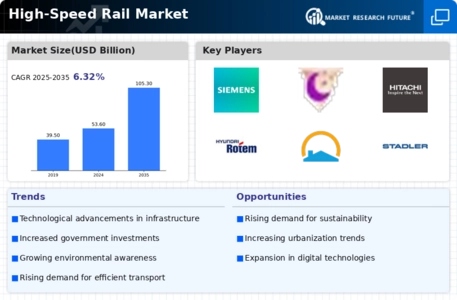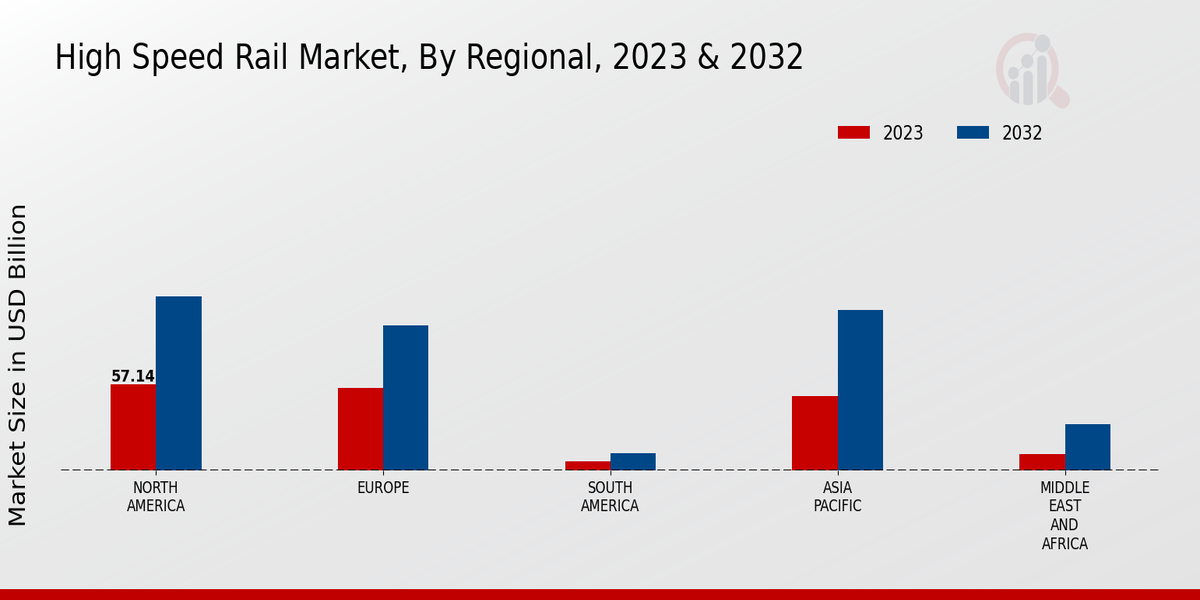Market Growth Projections
The Global High-Speed Rail Market Industry is poised for substantial growth in the coming years. With a projected market value of 53.6 USD Billion in 2024, the industry is anticipated to expand significantly, reaching an estimated 105.3 USD Billion by 2035. This growth trajectory suggests a robust compound annual growth rate (CAGR) of 6.32% from 2025 to 2035. Factors contributing to this growth include increasing investments in infrastructure, technological advancements, and rising demand for sustainable transportation solutions. As nations prioritize efficient transit options, the high-speed rail market is likely to flourish, reflecting a global shift towards modern and eco-friendly travel.
Government Investments and Support
Government investments play a crucial role in the Global High-Speed Rail Market Industry. Many nations recognize the economic and environmental benefits of high-speed rail and are committing substantial resources to develop and expand these networks. For example, the European Union has allocated significant funding for high-speed rail projects, aiming to enhance connectivity across member states. Such investments not only facilitate infrastructure development but also stimulate job creation and economic growth. As a result, the market is expected to grow, with projections indicating a value of 105.3 USD Billion by 2035, driven by ongoing governmental support and funding initiatives.
Rising Fuel Prices and Economic Factors
Rising fuel prices and economic factors are driving the Global High-Speed Rail Market Industry. As fuel costs continue to fluctuate, consumers and businesses are increasingly seeking cost-effective transportation solutions. High-speed rail offers a competitive alternative, often providing lower travel costs compared to air travel and personal vehicles. Additionally, economic factors such as inflation and disposable income levels influence travel choices, with many opting for high-speed rail as a budget-friendly option. This trend is likely to contribute to the market's growth, with projections indicating a value of 105.3 USD Billion by 2035, as more individuals prioritize economical travel.
Technological Advancements in Rail Systems
Technological advancements are transforming the Global High-Speed Rail Market Industry, enhancing the efficiency and safety of rail systems. Innovations such as advanced signaling systems, energy-efficient trains, and automated operations are being integrated into high-speed rail networks. These developments not only improve travel times but also reduce operational costs, making high-speed rail more competitive against other modes of transport. Countries like China are at the forefront of these advancements, boasting the world's largest high-speed rail network. The continuous evolution of technology is likely to drive market growth, contributing to a projected CAGR of 6.32% from 2025 to 2035.
Growing Demand for Sustainable Transportation
The Global High-Speed Rail Market Industry is experiencing a surge in demand for sustainable transportation solutions. As urbanization accelerates, cities are seeking efficient alternatives to reduce congestion and carbon emissions. High-speed rail systems offer a viable solution, providing rapid transit options that are less polluting than traditional modes of transport. For instance, countries like Japan and France have successfully integrated high-speed rail into their transportation networks, demonstrating its potential to alleviate traffic woes. This growing emphasis on sustainability is projected to contribute to the market's expansion, with an estimated value of 53.6 USD Billion in 2024, reflecting a shift towards greener travel options.
Increasing Urbanization and Population Growth
The Global High-Speed Rail Market Industry is significantly influenced by increasing urbanization and population growth. As more people migrate to urban areas, the demand for efficient transportation solutions intensifies. High-speed rail systems provide a rapid and reliable means of travel between densely populated regions, addressing the challenges posed by urban sprawl. For instance, cities in India are exploring high-speed rail options to connect major urban centers, reflecting a global trend. This demographic shift is expected to bolster the market, with an anticipated value of 53.6 USD Billion in 2024, as urban populations seek modern transportation alternatives.




















